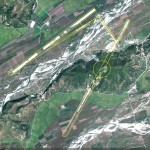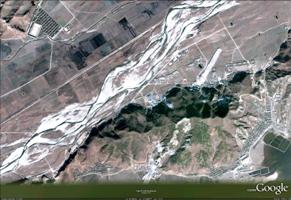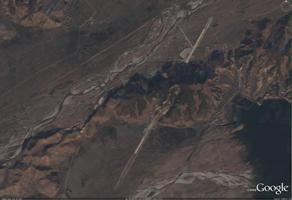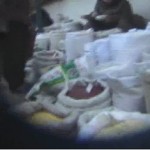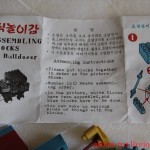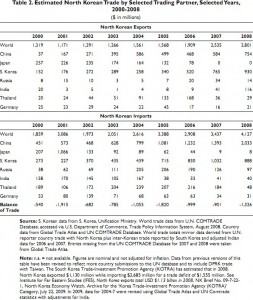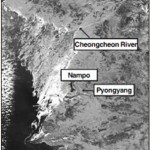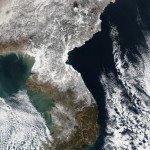UPDATE 2 (2011-4-25): Strategy Page comments on the technology that makes these facilities obsolete:
Over the last decade, there has been a pronounced slowdown in North Korean work on underground air bases. Part of this may be the result of growing energy shortages up north, and the frequent blackouts. It’s not just electricity that’s been in short in North Korea over the last decade, it’s everything. That includes construction equipment, especially the specialized stuff needed for digging tunnels into the sides of mountains. But work continues, slowly, mostly with manual labor, to expand the network of underground parking and maintenance facilities for aircraft, as well runway extensions. These sheltered air bases begin underground, then exit the mountain and continue outside. Apparently the North Koreans have figured out that the Americans have now developed weapons that could quickly shut down these underground facilities, and keep them inoperable.
One of the key weapons for doing this is the U.S. Air Force 129 kg (285 pound) Small Diameter Bomb (SDB). The official story was that this GPS guided smart bomb was needed for urban warfare. The smaller blast (17kg/38 pounds of explosives, compared to 127 kg/280 pounds for the 500 pound bomb) from the SDB resulted in fewer civilian casualties. Friendly troops can be closer to the target when an SDB explodes. While the 227, 455, 911 kg (500, 1,000 and 2,000 pound) bombs have a spectacular effect when they go off, they are often overkill. The troops on the ground would rather have more, smaller, GPS bombs available. This caused the 227 kg (500 pound) JDAM to get developed quickly and put into service. But the smaller SDB was always a mystery, with many produced, but few actually used.
But the SDB also has a hard steel, ground penetrating, front end, that can penetrate nearly two meters (six feet) of concrete. Not much use for that in urban warfare. But such a capability is very useful for taking out underground installations, particularly the entrances and air intakes. North Korea, for example, has twenty airfields with underground hangars for the aircraft. Usually tunneled into a nearby hill or mountain, the underground hangar allows fighters and bombers to quickly taxi out onto the runways and take off. Since North Korea doesn’t have that many operational warplanes, it’s believed that some of these “airfields” actually have long range rockets and ballistic missiles, mounted on trailers equipped to erect the missile into launch position and fire it off, in the underground hangars. The trailers are hauled out of the tunnels, onto the air field, the missile fired, and then the trailer is taken back inside to be reloaded. The North Koreans also have hundreds of other, smaller, underground facilities, close to the South Korea border, containing artillery and rocket launchers. These weapons are meant to be quickly hauled out and fired south.
That’s where the SDB comes in, but the U.S. Air Force isn’t saying much about it. The SDB would be the ideal weapon for launching a surprise attack on North Korean underground facilities, both the airfield hangers and the artillery bunkers. American B-2 and F-22 aircraft can dodge North Korea radar and drop a lot of SDBs all at once. A B-2 can carry over 200 SDBs. An F-22 can carry eight, and still protect the B-2s against any North Korean fighters that might have been in the air at the time of the attack. A half dozen B-2s carry over 1,200 SDBs, which is sufficient to cripple North Korean air defenses and twenty key air bases. A few dozen F-22s carry another 300 SDBs to hit smaller, spread out targets. The SDBs not only shut down the entrances to the hangars, but also blow deep holes in the airfields. While North Korea has thousands of troops trained and equipped to quickly come in and clear the hangar entrances and repair the airfields, they are not quick enough to do so before unstealthy B-1s and B-52s come in with more smart bombs (and cluster bombs, carrying thousands of small booby traps, that explode when stepped on or rolled over by vehicles or engineering equipment).
UPDATE 1 (2011-4-15): The Kangda-ri AFB* (Thunderbirds Runway) is slowly expanding.
In the Google Earth image above (dated October 3, 2009), I have outlined the runway infrastructure in yellow. The northern most runway is new but displaces and older highway airstrip. A bridge is under construction which would link the new runway with the one that passes through the mountain.
The main runway is unchanged in length since the previous image was taken in December 2007. The secondary runway is appx 1920 meters long.
The construction site is receiving electricity from a nearby substation just northwest of the facility. Currently the power cables are above ground and cross the runway (in green).
There is a similar facility in Onchon on the DPRK’s west coast. You can find a good description of it in The Armed Forced of North Korea.
* I use the name “Kangda-ri” AFB because this was the name Joseph Bermudez gave to the original highway strip in The Armed Forced of North Korea.
**This picture was picked up by Radio Free Asia, Yonhap, and the Wall Street Journal’s Korea Real Time.
ORIGINAL POST (2009-12-17): Although KCNA has not reported on it, the KPAF is making slow but steady progress on its east coast “Thunderbirds runway” just southwest of Wonsan (location here). Construction had begun by Nov 11, 2002 when the image below was captured:
At the time this photo was taken the facility was in the early phases of construction, and the runway measured just over 1,500 m (According to Google Earth). In fact the only way I could be sure it was a runway was because there was already a similar facility on the west coast–north of Nampo at Onchon AFB (Located here). As an aside, if you would like to learn more about the Onchon AFB, Joseph Bermudez offers some information in The Armed Forced of North Korea.
Well, here is how the place looked December 24, 2007:
The runway foundation now extends nearly 2,450 m and we can see the outline of a functional runway appear. The runway foundation is probably constructed from materials that are mined from the tunnels they are digging into this mountaion. I am sure there is someone out there more qualified than I to calculate the size of the underground facility based on the amount of rubble they have used on the runway.
The rate of progress is surprisingly slow which is also evidence (though not definitive) that much of this work is being done manually. At this pace lets hope they finish by 2012.
